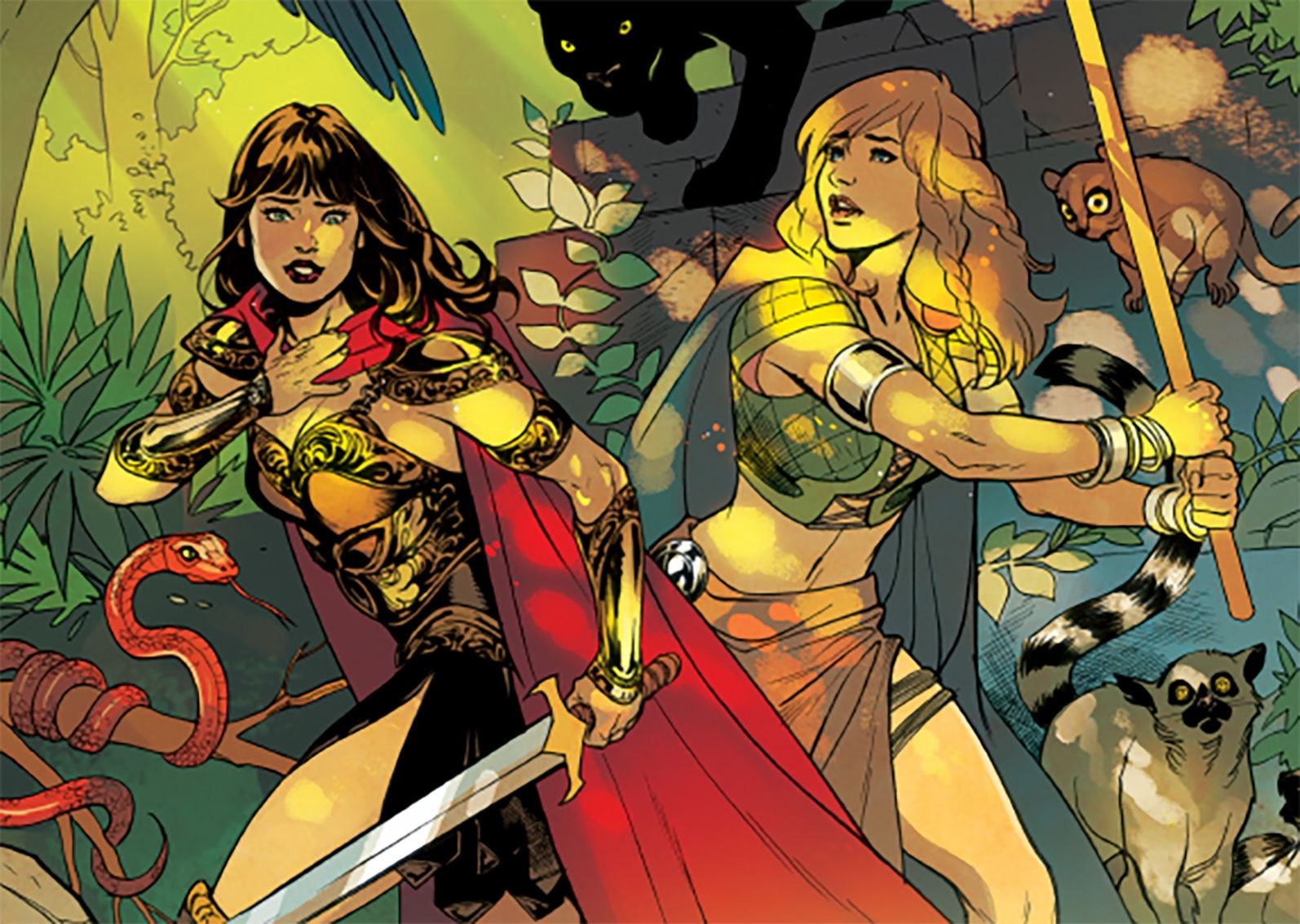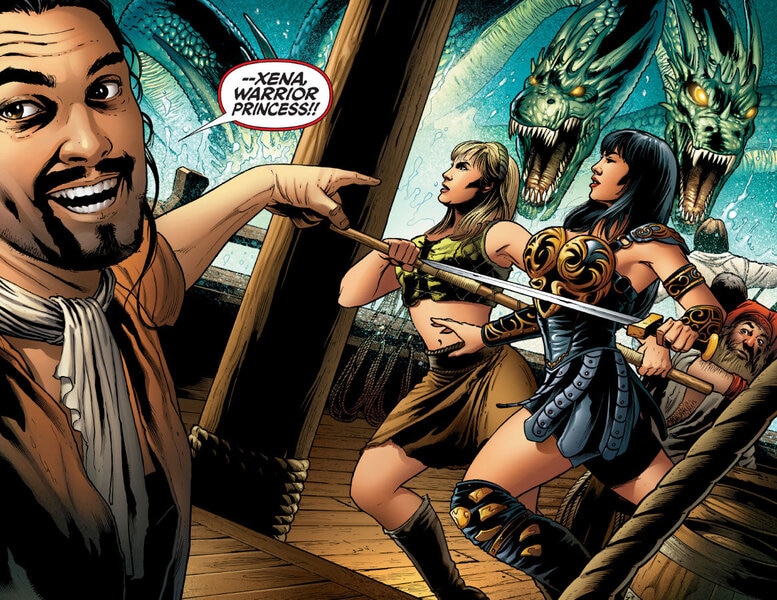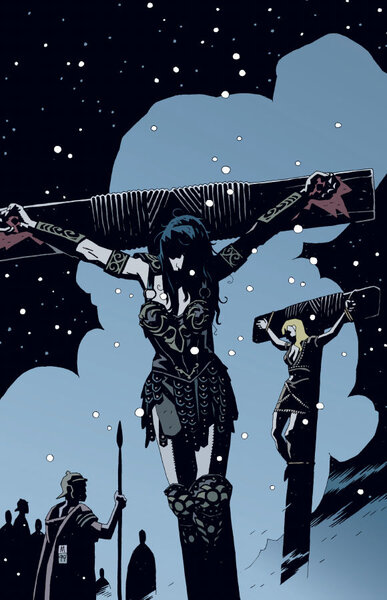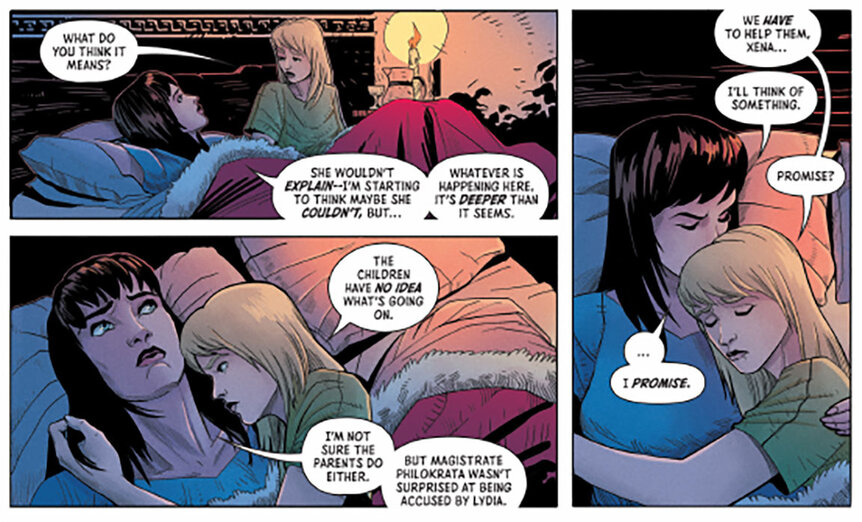Create a free profile to get unlimited access to exclusive videos, sweepstakes, and more!
Why the new Xena comic series is a must-read for longtime fans

It was only shortly after the debut of the TV series that we first began to see Xena: Warrior Princess comics on the shelves, and what a wild ride it’s been. Initially published through the short-lived line by the trading card company Topps, this was followed by a short stint at Dark Horse, and finally, a move over to Dynamite Entertainment in 2007, the company which comic book Xena currently calls her home. Several of the best writers and artists the industry has to offer have worked on her various series, such as Genevieve Valentine, Amanda Conner, Jimmy Palmiotti, and June Brigman, with covers by superstars like Alex Ross, Mike Mignola, Erica Henderson, and Jenny Frisson, but Xena comics have remained mostly under the radar for the last 20-plus years.
In 2019, we saw another Xena reboot take shape in the form of Vita Ayala’s Xena. Ayala, who refers to Xena as their “number one favorite character of all time,” teamed up with Olivia Sweetman and several other artists to bring us a new, perhaps more definitive take on the Warrior Princess than we’ve seen in comics up to this point. If you’re a fan of the show who has slept on the comics line, there is no better time than now to pick them up.
In The Beginning
Admittedly, the early years of Xena comics were a bit of a mess. Stories that returned the Warrior Princess to being an auxiliary sidekick to Hercules weren’t likely in high demand by her fans, and issues spotlighting Joxer or a prank marriage between Xena and Hercules weren’t well-received. Still, the popularity of the character ensured some sales, and the comics were at least as entertaining as the worst episodes of the TV series. The Topps comic line folded fairly quickly, and licensing rights were gained by Dark Horse.
Overlapping with the fifth and sixth seasons of the TV show, the 1999 Dark Horse series can be viewed, in hindsight, as the beginning of more subversive Xena stories. The first eight issues were written by John Wagner, best known as the co-creator of Judge Dredd (alongside Carlos Ezquerra), and the off-the-wall writing style that made early Dredd comics so entertaining translated surprisingly well to the world of Xena. Kicking it off with the two-parter "The Warrior Way of Death," Wagner opened the arc with Xena and Gabrielle being crucified in the middle of a snowstorm. This will be familiar imagery to most fans of the TV series, and indeed, Xena’s crucifixion at the hands of Caesar was frequently revisited over the years. Yet, this comic proceeded to go fully off the rails after the opening scene, following Xena’s nemesis Callisto as she vanished back to a visually explosive take on Hell that, for many reasons, would not have made it to network television.
This run was out of control in all the ways you love to see, and over the course of only eight short issues it included all kinds of surprising moments — from multiple deaths and trips to Hell to some truly bizarre and haunting images, like a hybrid man-boar climbing out of a woman’s skin through her mouth in an attempt to kill our heroes. Joyce Chin’s pencils are exceptionally good for any occasion, but she brought it tenfold to the Xenaverse with inker Walden Wong and colorist Dave McCaig. Double-page spreads abound, and the amount of detail in the work goes above and beyond. The characterization isn’t always exactly spot-on, but as an epic Xena story through several different planes of reality, it’s a heck of a lot of fun and captures the truly outrageous nature of the show’s plotlines.
The creative team changed fairly regularly throughout the run of this series, but everyone was working at the top of their game and it was an excellent read overall. Though the relationship between Xena and Gabrielle was not explicitly queer, similar to the TV series itself, the arc did nonetheless end on the two women holding each other in a shadowy room, with Gabrielle saying, “As long as you want me, I’ll be there beside you, friend.” True gal pals, indeed.
The Dynamite Years
Dynamite’s first Xena series hit the stands in 2006, five years after the TV show had wrapped. In continuity, Xena had died, but the comic series has always seemed to jump around and merge timelines without explanation. Fortunately, for Xena fans, this wasn't be anything new, considering the liberties the show itself often took when it came to chronology. These series tended to lean more towards establishing the comic book status quo of Xena, and so there weren't a lot of huge, earth-changing events. Several guest appearances were crammed into a relatively small space, we ran through a disparate cast of various Gods, and we saw the unfortunate return of Joxer.
In the "All Roads" story by Genevieve Valentine and artist Ariel Medel, the story focused around Gabrielle's premonitions of Xena’s potential death and everything she tried to prevent it from happening. This definitely set the story outside of the end of the series, in which Xena was deceased, but by giving focus to Gabrielle it actually did more for the mythos than most of the comics by adding this fresher perspective of the series. In this, Xena and Gabrielle were absolutely partnered, even sharing an intimate moment in bed at one point — the first we saw of them as a real, on-panel couple. The tenderness of Gabrielle’s affection for Xena took center stage, while Xena demonstrated her own growth by trusting Gabrielle and refusing to leave her behind even when it might have been easier to do so. This series was one of the most interesting from a personal level, as it showed us a fairly standard Xena story through the lens of the person who loved her the most.
After that, though only for a short time, comic Xena lost her way a bit. Two five-issue stints by Meredith Finch and Erica Shultz attempted to redefine Xena and Gabrielle’s first meeting, but as that had previously been dealt with in the first episode of the TV series and we’d seen so much development between them since, it was the kind of back-to-basics approach that couldn’t be as interesting as the continued evolution of the characters themselves. While these comics are well-written and generally pretty fun to read, they seemed regressive to longtime Xena fans, and the series ended fairly quickly.
And Now, For Something A Little Bit Different
With the exception of the highly entertaining Army of Darkness/Xena crossover series, that wraps up the history of Xena in comics and brings us to the Ayala run. Again, Xena fans have something to get excited about here, as Ayala's reboot offers many callbacks to the TV show while keeping things accessible for readers that might not ever have seen an episode of the seminal series. Taking place somewhere in the middle of show continuity (as Gabrielle is still wearing her green crop top and wielding a bo staff), this series drops us in the middle of a standard X: WP conflict in which Xena must find a compromise and help others to rise above their oppression. This quickly goes off the rails when Zeus exiles the minor god Discord, sending both Xena and Gabrielle along with her to parts unknown. This kicked off the currently ongoing Xena world tour, giving readers short, self-contained tales in interesting new locations among brand new characters. Praise for this series has been consistent among reviewers, and for Xena fandom, it’s a must-read.
In contrast to rebuilding the Xena/Gabrielle dynamic from scratch or downplaying their status as essentially a married couple, Ayala focuses on giving us quiet, romantic moments between them. This helps to ease a lot of the angst from the constant unfulfilled romantic tension between them that one might experience after watching the TV series. It is the Xena/Gabrielle relationship at its best, with the two of them leaning on each other and learning from one another through these subtle displays of intimacy. Whole conversations take place as they spoon each other in bed, giving us perhaps the clearest definition of their existence as a functional couple rather than the “tight-knit best friends” that they have so often been played off as. The comic series is not only excellent for its adventurous quality; the clear portrayal of Xena and Gabrielle as being, at the very least, lowkey romantically involved is also long overdue.
Xena is a character who broke a heck of a lot of ground in a whole lot of ways, and it’s great to see that we haven’t reached the end of her evolution. Even without a reboot of the Xena TV series, she has lived on in the comics. In some ways, these series have added to her quest and allowed fans to revisit a beloved cast of characters. With the new ongoing, we can only hope that this is the beginning of a new evolution of Xena stories for a generation who might not have firsthand experience with the revolutionary nature of the TV series. Besides that, the comics have given us the most consistent admission of a love affair between her and Gabrielle, and after the constant subtext tease of the TV series, that’s a huge deal for queer fans.
The views and opinions expressed in this article are the author's, and do not necessarily reflect those of SYFY WIRE, SYFY, or NBC Universal.

















